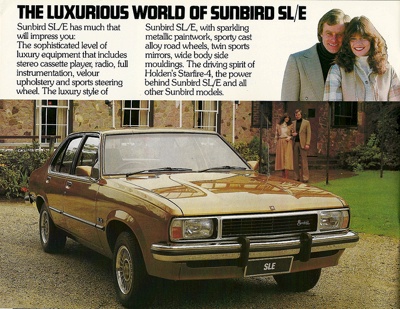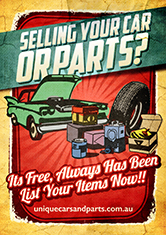Holden UC Sunbird
Reviewed by Unique Cars and Parts
Our Rating: 1
An Underpowered Torana
There was no way the Sunbird could ever hope to keep up with the larger engined Torana. Not in a straight line, not even in a corner. The two may have looked identical, but when you were behind the wheel of a Sunbird you knew there was a difference. The Sunbird felt like an underpowered Torana. Not that it was a bad car, but because of its size and the way it felt on the road, the Sunbird, understandably, would always feel like a Torana without any go.
GM first introduced the Sunbird in November
1976. It replaced the Torana 1900, a less than successful car for the General. The Sunbird used the same concept as the 1900, that was a Torana body fitted with the 1897cc four cylinder engine, but the Sunbird had one very important difference – it was the first GM car to get the famous RTS
suspension changes. And, as some Ford aficionados would claim, that made it the very first Holden that could handle.
Thanks to a favourable press reaction, the Sunbird sold very well in its early days - the new thing (to GM anyway) called handling proved to be a great sales boom. Sales dropped a little bit as time wore on, the Sunbird being knocked about by the Japanese who, in the eyes of the buying public, offered better value for money. But at least the Sunbird had reached GM's sales target.
Radial Tuned Suspension Phase 2
With the introduction of the UC Torana/Sunbird range came phase two of the General's RTS suspension programme. We've covered RTS changes in other articles on this site, suffice to say that GM improved an already good handling car even further. But while the car may have been better, sales never reached expectiations leaving the good folk at Fishermens Bend somewhat disappointed.
The
Torana was selling as per expectations - so why was the Sunbird on the nose? After much analysis there was one problem that the Sunbird faced - and that problem was the
Sigma. And the problem didn't only apply to the Sunbird: all cars, particularly tne long-time previous market leader,
Datsun, were suffering the onslaught of the men from
Mitsubishi. By the middle on
1978 sales of the Sunbird were only half that of the
Sigma/
Scorpion.
The "Ultra Conservative"
There was some good news though, as the Sunbird headed the Cortina 4 by a considerable margin, a margin far greater than had been the norm in the past. Generally, the Cortina had been slightly in front. The point of all this was that while the Torana continued to sell well, the Sunbird wasn't. Perhaps people were being turned away by the anal styling of the UC - at the time there was a saying that UC actually stood for "Ultra Conservative" (remember the saying that
HD stood for "Holden Disaster", and
HR for "Holden Recovery"?).
We can only assume the savings at the dealership were enough to tempt you out of a Torana and into a Sunbird - because by any measure we would not think fuel savings would be a major factor. To really understand what the Sunbird was all about, perhaps you had to drive one. The base Sunbird cost $5925, but after options were added, this became $6504. On the options list were four wheel discs, tinted side windows and laminated/band tinted windscreen, dual wiper control, quartz-halogen headlights, cloth trim, full instrumentation and metallic paint.
To bring a Sunbird up to the specifications of the competition (read
Sigma), you would need to tick all the options, and then you would end up with a slower car with a higher price tag. But there was one ace up the sleeve, the Sunbird was a great handler, it felt like it would hang on forever. There was just a shade of initial understeer, and if really pushing, you would get a little power oversteer. However the power of the engine was such that it restricted you from overstepping the limit. Put simply, the car's limits were higher than its top speed in almost all situations.

The SLE Holden UC Sunbird came with all the options.
|
A Better Ride than Torana
The ride was great too. Somehow it was smoother than the Torana's ride, perhaps less weight in the front gave the car better balance. There was no harshness, no noise, no body roll. Only over ripply surfaces did the rear axle get caugnt out and transmit vibration to the cabin. The steering was a little heavy at parking speeds but was damn near perfect on the move. As was typical with GM cars from this era, there was a lack of feel on the straight ahead, but any movement brought a precision that was hard to beat.
What was left was all very much like a Torana, as were the
brakes - four wheel discs which were optional and worked superbly - and the gearbox. For some reason plenty of Sunbirds that left the factory had the clutch taking up very close to the floor, makind it hard to master smooth gear changes. The problem was only a matter of adjustment. The gearbox didn't suffer the annoying movement on its mountings that Torana 6's did.
The Starfire 4
The engine is what really separated the Sunbird from the
Torana. The 1897cc
Starfire Four was a pretty basic and agricultural engine that had been around for a while. In the Sunbird it did a reasonable job of pushing along such a large car, but it required heavy use of the gears and you needed to plan well ahead if you wanted to keep the car moving along. But no matter how well you drove the Sunbird, or how much effort you put into getting every bit of power out of the engine, it was never a match for its bigger engined brother.
Whether you were pushing the Sunbird or not, the engine let you know it was there. At idle, there was a not too unpleasant "note" emitting from the engine bay but that increased to a boom when the engine reached around 3800 rpm. It quietened down again at 4500 rpm, but you stil! wouidn't have called it quiet. In the comfort/equipment stakes the Sunbird came up well. The seats were good, as was the dash and control layout. Full instrumentation (optional) meant speedo, tacho (including small clock), fuel, oil, temp and amps gauges.
The interior atmosphere was one of brightness, spaciousness and that was despite the pretty cramped rear seat. Airy was the best way to describe it. Basically the Sunbird felt like a Torana but didn't possess that cars instant throttle response. You had to stir it along with the gears and plan ahead. For everyday motoring it was ok - but with a small motor pushing along a medium sized and relatively heavy car, it was always going to remain in the shadows.
Holden UC Sunbird Quick Specifications:
Car: General Motors Holden UC Sunbird; Price basic - $5925; With most of the options - $6504; Options - Four wheel discs ($221), tinted windows & laminates screen ($153), delay wiper control ($24), Quartz-halogen ($26), full instrumentation ($86), cloth trim ($45), metallic paint ($24).
Engine: Starfire 4 Iron construction 4 cylinder in line; 1897cc; OHC; Compression ratio - 8.8:1; Bore and Stroke (mm) - 93.0 x 69.8; Power output at 5200 rpm (Kw/bhp)72/96.5 Torque at 3600 rpm (Nm/lbs ft) 157/115.7.
Transmission: Four speed manual; Ratios - 1st - 3.40:1; 2nd - 2.16:1; 3rd - 1.38:1; 4th - 1.00:1; Final drive - 3.90:1
Body/Chassis: Unitary Construction, Steel panels; Weight (kg) - 1154; Dimensions (mm): Length - 4499; Width - 1704; Height - 1331; Wheelbase - 2586; Front track - 1415; Rear track - 1382.
Suspension: Front -
RTS, independent,
coil springs,
anti-roll bar, telescopic shockers. Rear -
RTS (
Radial Tuned Suspension), live Salisbury axle,
coil springs, telescopic shockers,
anti-roll bar.
Brakes: Power assisted four wheel disc; Front - 254mm disc; Rear- 266.2mm disc.
Steering: Rack and pinion; Turns lock to lock - 3.8; Turning circle - 10.9 m
Wheels/Tyres: Pressed steel; Diameter- 13 in; Rim width - 5 in; Tyre make - Goodyear; Type - Steel radial; Dimensions - AR78 S13.
Performance: Acceleration from standstill to: 60 km/h - 6.1; 80 km/h - 9.8; 100 km/h - 13.9; 120 km/h - 20.6; 140 km/h - 31.2; 60 to 100 km/h - 8.2; Standing start 400 metres: 20.7 sec / Terminal speed - 118 km/h. Maximum speeds in gears: 1st 48 km/h @ 5500 rpm, 2nd - 73 km/h @ 5500 rpm, 3rd -117 km/h @ 5500 rpm, 4th - 160 km/h approx. Braking - 110 km/h to zero: (average distance taken in metres) - 48.0; Fuel consumption (litres per 100 km/mpg) - 9.7/28.7; Tank capacity - 55 litres.




Drawbacks - boot leaks over time playing havoc with the tail lights - that's about it for me anyway. The front and rear end, bonnet, interior changes over the LX were a masterstroke. The car still looks ageless.